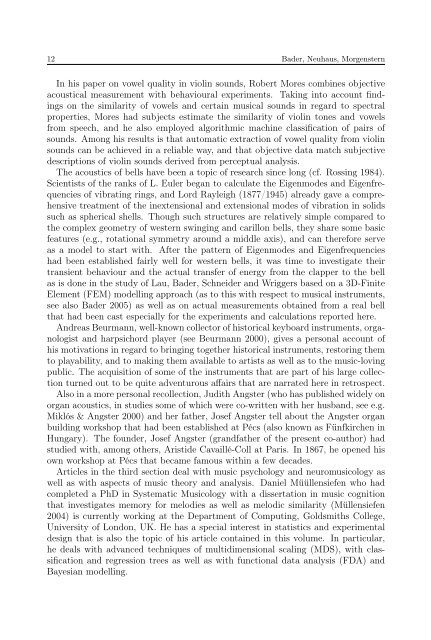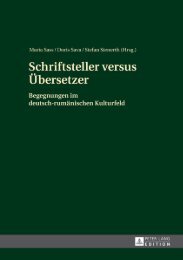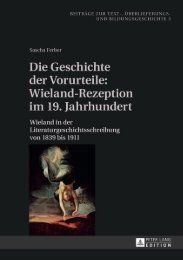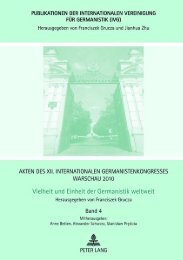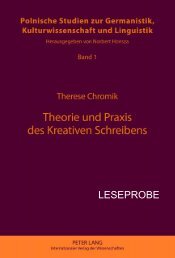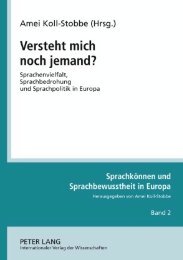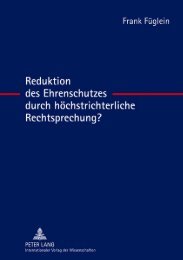Extract (PDF) - Peter Lang
Extract (PDF) - Peter Lang
Extract (PDF) - Peter Lang
Create successful ePaper yourself
Turn your PDF publications into a flip-book with our unique Google optimized e-Paper software.
12 Bader, Neuhaus, Morgenstern<br />
In his paper on vowel quality in violin sounds, Robert Mores combines objective<br />
acoustical measurement with behavioural experiments. Taking into account findings<br />
on the similarity of vowels and certain musical sounds in regard to spectral<br />
properties, Mores had subjects estimate the similarity of violin tones and vowels<br />
from speech, and he also employed algorithmic machine classification of pairs of<br />
sounds. Among his results is that automatic extraction of vowel quality from violin<br />
sounds can be achieved in a reliable way, and that objective data match subjective<br />
descriptions of violin sounds derived from perceptual analysis.<br />
The acoustics of bells have been a topic of research since long (cf. Rossing 1984).<br />
Scientists of the ranks of L. Euler began to calculate the Eigenmodes and Eigenfrequencies<br />
of vibrating rings, and Lord Rayleigh (1877/1945) already gave a comprehensive<br />
treatment of the inextensional and extensional modes of vibration in solids<br />
such as spherical shells. Though such structures are relatively simple compared to<br />
the complex geometry of western swinging and carillon bells, they share some basic<br />
features (e.g., rotational symmetry around a middle axis), and can therefore serve<br />
as a model to start with. After the pattern of Eigenmodes and Eigenfrequencies<br />
had been established fairly well for western bells, it was time to investigate their<br />
transient behaviour and the actual transfer of energy from the clapper to the bell<br />
as is done in the study of Lau, Bader, Schneider and Wriggers based on a 3D-Finite<br />
Element (FEM) modelling approach (as to this with respect to musical instruments,<br />
see also Bader 2005) as well as on actual measurements obtained from a real bell<br />
that had been cast especially for the experiments and calculations reported here.<br />
Andreas Beurmann, well-known collector of historical keyboard instruments, organologist<br />
and harpsichord player (see Beurmann 2000), gives a personal account of<br />
his motivations in regard to bringing together historical instruments, restoring them<br />
to playability, and to making them available to artists as well as to the music-loving<br />
public. The acquisition of some of the instruments that are part of his large collection<br />
turned out to be quite adventurous affairs that are narrated here in retrospect.<br />
Also in a more personal recollection, Judith Angster (who has published widely on<br />
organ acoustics, in studies some of which were co-written with her husband, see e.g.<br />
Miklós & Angster 2000) and her father, Josef Angster tell about the Angster organ<br />
building workshop that had been established at Pécs (also known as Fünfkirchen in<br />
Hungary). The founder, Josef Angster (grandfather of the present co-author) had<br />
studied with, among others, Aristide Cavaillé-Coll at Paris. In 1867, he opened his<br />
own workshop at Pécs that became famous within a few decades.<br />
Articles in the third section deal with music psychology and neuromusicology as<br />
well as with aspects of music theory and analysis. Daniel Müüllensiefen who had<br />
completed a PhD in Systematic Musicology with a dissertation in music cognition<br />
that investigates memory for melodies as well as melodic similarity (Müllensiefen<br />
2004) is currently working at the Department of Computing, Goldsmiths College,<br />
University of London, UK. He has a special interest in statistics and experimental<br />
design that is also the topic of his article contained in this volume. In particular,<br />
he deals with advanced techniques of multidimensional scaling (MDS), with classification<br />
and regression trees as well as with functional data analysis (FDA) and<br />
Bayesian modelling.


